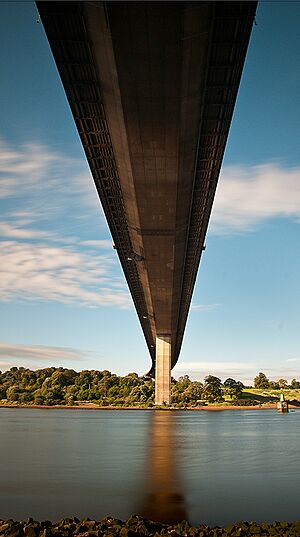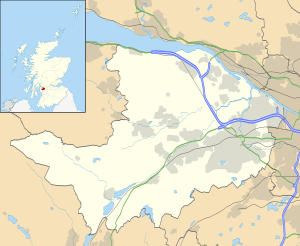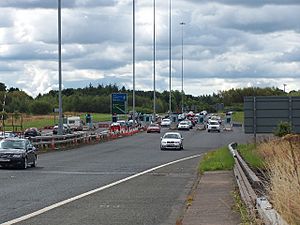Erskine Bridge facts for kids
Quick facts for kids Erskine Bridge |
|
|---|---|
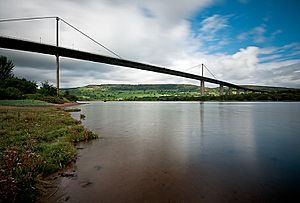
View of the Erskine Bridge from the south bank of the River Clyde
|
|
| Coordinates | 55°54′48″N 4°28′20″W / 55.9133°N 4.4721°W |
| Carries | Motor vehicles, cyclists, pedestrians |
| Crosses | River Clyde |
| Locale | Erskine, Scotland |
| Official name | Erskine Bridge (A898) |
| Maintained by | Transport Scotland |
| Characteristics | |
| Design | Box girder bridge |
| Material | Steel, concrete |
| Total length | 1,321.87 m (4,336.8 ft) |
| Width | 31.25 m (102.5 ft) |
| Height | 45 m (148 ft) |
| Longest span | 305 m (1,001 ft) |
| Number of spans | 15 |
| Load limit | 500 t (490 long tons; 550 short tons) |
| Design life | 120 years |
| History | |
| Architect | R.E. Slater |
| Designer | Dr William Brown |
| Constructed by | Freeman Fox & Partners, W.A.Fairhurst and Partners, Christiani & Nielsen, Lehane, Mackenzie and Shand Ltd |
| Fabrication by | Fairfields-Mabey |
| Construction begin | 1967 |
| Construction cost | £10.5 million |
| Inaugurated | 2 July 1971 |
| Replaces | Erskine Ferry |
| Statistics | |
| Daily traffic | ~35,000 vehicles |
| Toll | Free |
The Erskine Bridge is a really big bridge in west central Scotland. It has a special design called a box girder and uses strong cables to hold it up. This amazing bridge crosses the River Clyde, connecting West Dunbartonshire with Renfrewshire.
You can use the bridge whether you're in a car, on a bike, or walking. Besides the Clyde, it also crosses the Forth and Clyde Canal and a railway line. A small part of Kilpatrick railway station is even right underneath the bridge on the north side! The bridge is part of the A898 road and took the place of the old ferry service when it was finished.
Contents
Building the Erskine Bridge
The Erskine Bridge was designed by Dr William Brown, a talented engineer who specialized in bridges. He worked with a company called Freeman Fox & Partners. Another important person was Dr Oleg Kerensky, who supervised the project. The architect on site was R.E. Slater.
Many companies worked together to build the bridge between 1967 and 1971. Freeman Fox & Partners handled the main engineering. The steel parts were made by Fairfields-Mabey. Other companies designed and built the concrete supports, called piers, and the foundations.
Materials and Size
The bridge deck and tall supports (pylons) are made of strong steel. The piers are made from concrete. The road surface is a special type of asphalt. The bridge has two lanes for traffic in each direction, plus paths for bikes and walkers on both sides.
The main part of the bridge spans 305 m (1,001 ft) across the river. The total length of the bridge, including its approach roads, is about 1,321.87 m (4,336.8 ft). It stands 45 m (148 ft) high, allowing ships to pass underneath. At the time it was built, it was the longest bridge of its kind in the world!
Safety and Special Features
The Erskine Bridge has 15 sections and rests on 14 diamond-shaped piers. These piers are designed to let air flow around them. The bridge can even flex a little with temperature changes, which helps it last longer.
An interesting fact is that the bridge has single cables over its main supports. This design was later used for the famous Millau Viaduct in France.
During its construction, another bridge designed by Freeman Fox & Partners, the West Gate Bridge in Australia, sadly collapsed. An investigation found problems with its design. Because of this, the Erskine Bridge, which had just opened, needed extra strengthening to meet new safety rules.
Today, the bridge has a smart system that checks the weight of vehicles. It uses sensors and cameras to make sure trucks aren't too heavy. This system works all day and night.
Where is the Erskine Bridge?
The Erskine Bridge is part of the A898 road. On the south side, a short motorway called the M898 motorway connects it to the main M8 motorway. The bridge links the town of Erskine in Renfrewshire on the south side to the A82 road at Old Kilpatrick in West Dunbartonshire on the north side.
Because the bridge is built high up, it offers amazing views! You can see places like Erskine, Mar Hall, Dumbarton, and the River Clyde. You might even spot planes taking off from Glasgow Airport or see the Kilpatrick Hills.
The area around the bridge has a lot of history. Roman coins and an ancient artificial island called a crannog have been found nearby. The Erskine Bridge is the last bridge you'll find on the River Clyde before it reaches the sea. Its main job is to help traffic avoid the busy city of Glasgow, especially for tourists heading to beautiful places like Loch Lomond and the Highlands.
The Bridge and Tolls
For many years, the Erskine Bridge was a toll bridge. This meant drivers had to pay a fee to cross it. The toll booths were located on the south side of the bridge.
The bridge stopped charging tolls on March 31, 2006. Before that, from 1992, the toll was usually 60p for most vehicles. Motorcycles and certain vehicles like ambulances or those with disabled badges didn't have to pay.
There was even a time in 2001 when the bridge was briefly free because of a legal mistake! But new rules quickly brought the tolls back. When the tolls were finally removed in 2006, the Erskine Bridge was one of only three toll bridges left in Scotland. The other two, the Forth Road Bridge and the Tay Road Bridge, also became free in 2008.
When the tolls were removed, traffic on the Erskine Bridge increased a lot. Today, about 35,000 vehicles cross it every day. The bridge is now managed by Transport Scotland, which looks after Scotland's main roads.
Events at the Bridge
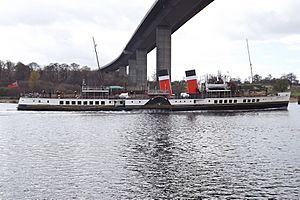
The Erskine Bridge has seen some unusual events! Two babies have actually been born on the bridge. The first was a boy in 1990, who was named Oliver Erskine Edwards after the bridge. Another baby girl was born in an ambulance on the bridge in 2011.
In 2010, a group of base jumpers used the bridge, which led to emergency services being called out.
A more serious event happened on August 4, 1996, when a large oil rig called the Texaco Captain hit the bridge deck. This caused the bridge to close for repairs. It reopened gradually, first for walkers and cyclists, then cars, and finally all vehicles by December 1996. The repairs cost a lot of money, but the bridge was made safe again.


